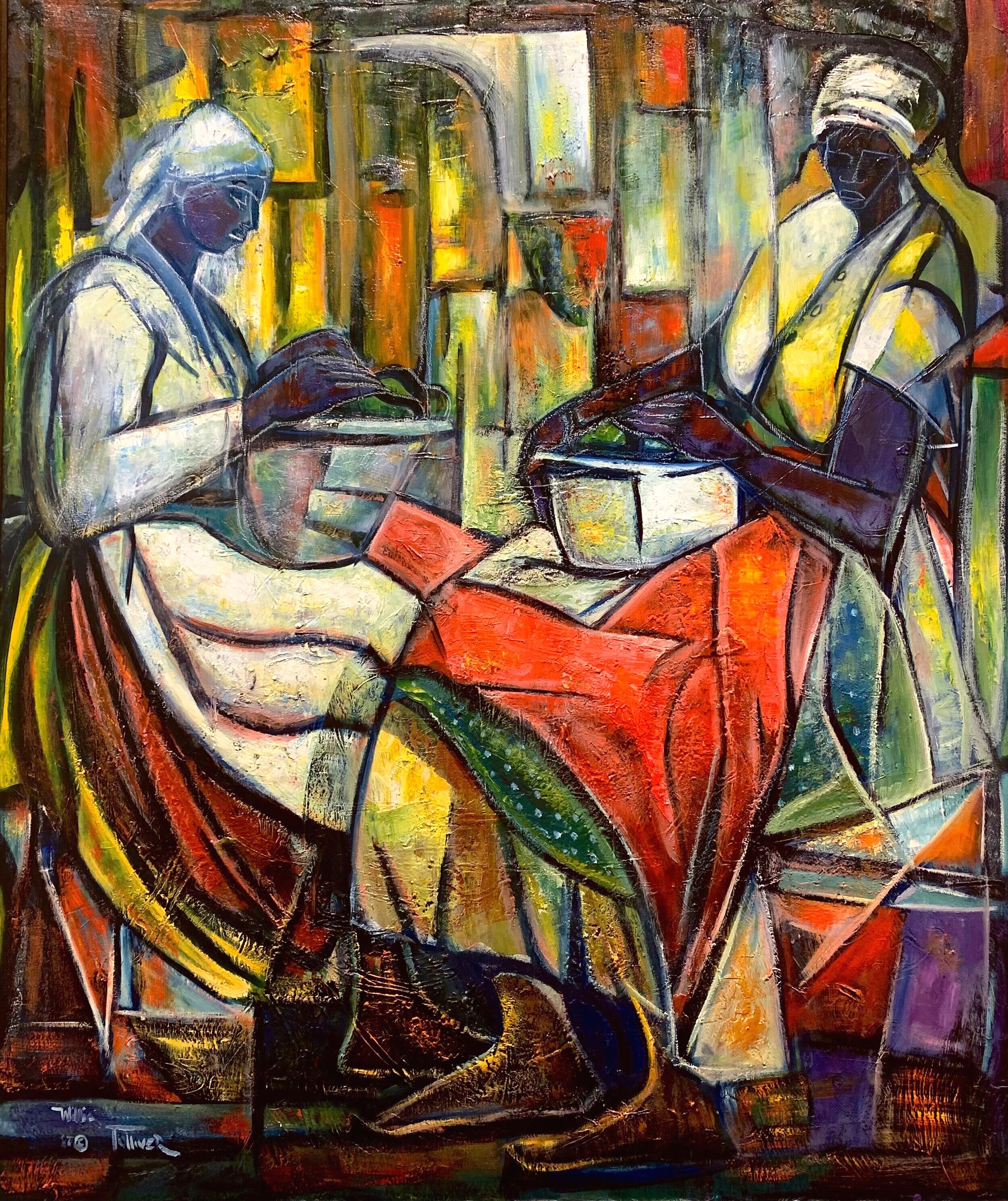Self-Made Mastery: Overdue Appreciation for Contemporary Artist William Tolliver
The Zigler Art Museum is home to one of the largest institutional collections of works by William Tolliver, a Black contemporary artist who was entirely self-taught. Today, I wanted to take the time to observe his lifelong dedication to his his studies, his family, his heritage, his craft—and the ways in which these unfold throughout his oeuvre.
“I love my work and I have worked very hard to portray African Americans with pride and dignity. My goal is to bring to the forefront the seriousness of art as a person’s heritage. I want my art to serve as a history lesson.”
To start off with a personal note, it is a major privilege to share a space with these paintings each day. It is not something you get used to, no matter how often you walk by Pea Shellers (left) in the gallery. The magnitude of this work goes beyond its imposing five and a half-foot height, and is in part thanks to the rich textures and colors that seem to cascade from the picture plane.
While his work is traditional in a formalist sense, his exploration of the limits of wet and dry media is a fairly modern venture. We’ll find that much of his career was spent maintaining the delicate balance between the proven methods of the old masters and his independent pursuit of contemporary creative liberation, resulting in a totally unique manner of creating.
See below for some detail shots of Pea Shellers, acquired by the Zigler estate in 1987:
Early Life
Born in Vicksburg, Mississippi, in 1951, William Tolliver showed an early curiosity for art that was enthusiastically supported by his busy mother, Ella Mae Tolliver. Though information about his family is scarce outside of what we can glean from his paintings, sharecropping was still a common practice in Mississippi until the 1960’s, around the time of his adolescence. We do know that his mother worked full time in cotton fields and took care of 14 children, and yet made time to encourage his interest by conducting drawing contests between the siblings and borrowing art books from the library. These books introduced him to European masters such as Michelangelo, da Vinci, Rembrandt, and Rubens.
Bypassing the lack of art education in his public school, the young artist learned how to mix and blend colors using a dime-store watercolor set purchased with his earnings from mowing lawns. According to an interview with Galerie Royale in New Orleans, he learned to make academically correct paintings at a young age by completing paint-by-number kits. “There is no better teacher,” he claims. “Everything is diagrammed, every little spot, every color. Once I did one or two of those, I understood the principles.” One could speculate that the nature of paint-by-numbers, accompanied by an academic understanding of modern art history, could have influenced his later cubist-style works that featured hard, dark outlines and strategically flooded color fields.
Tolliver would also closely study the art books to create detailed copies of the reproductions within. Though this intense observation served him well in a technical sense, he confessed to experiencing a “feeling of emptiness” toward realistic art. He notes that a significant moment in his development was at age 13 when he discovered the work of Vincent van Gogh—an abstract expressionist and similarly self-taught artist.
“Van Gogh painted purely for the love of it. I can relate to that. I also like his use of color, the way the light was reflected in his paintings, the powerful feeling in his work.”
Tolliver’s heavily impastoed Hints of Autumn (above, acquired 1986) demonstrates subtle ways in which van Gogh may have influenced his early work. The variations in chromatic whites stand out to me, especially compared to van Gogh’s Green Wheat Fields, Auvers (above right, 1890). These shifts, as well as the deliberately placed and clearly defined strokes, convey that Tolliver may have internalized these techniques during his formative years—though he didn’t consider himself a serious artist until later.
Leaving Home
At only 14 years old, William Tolliver left Vicksburg to join the Job Corps in Los Angeles, California. There, he studied carpentry and began an apprenticeship with his instructor and fellow visual artist. This mentorship led Tolliver to take a job at a sculptor’s studio in Milwaukee, Wisconsin, placing him in a community of career artists whose experience and trusted advice allowed him to see the value in his own work. After this key time in his development, he returned to Vicksburg to work in construction by day and continue painting at night. Used to long hours, he worked dutifully to support himself but never lost the impulse to create. In 1977, he got married and started his own family.
The 1980s oil boom in Lafayette, Louisiana, along with the growing need to provide for his family, prompted Tolliver to move his wife and children there so he could take a job as a house painter. Due to the tumultuous nature of the oil industry, however, he was laid off two years later and returned to painting as a way to seek refuge.
At a Crossroads
Likely out of a need for income, his wife Debrah urged him to show his work to a gallery. She saw his talent and knew others would too—so much so, that she took it upon herself to bring nine of his early landscapes to Bob Crutchfield, owner of Live Oak Gallery. To William’s shock and Debrah’s relief, all nine of the paintings sold within ten days.
Below are some examples of his early landscapes in our collection. They were purchased from Live Oak Gallery in 1985, however our records do not indicate whether they were included in the nine original pieces mentioned above.
This breakthrough lit a fire in him. He further developed his unique style into what he called “representational abstract expressionism” and got busy creating new work to show the gallery. Tolliver’s new style left Crutchfield so speechless that he mistook his silence for disappointment, so Crutchfield recalls having to stop him from gathering the paintings and leaving the gallery. Crutchfield saw that he had reached a dynamic creative level, and upon assuring him that the work was remarkable, he sold the new pieces from the gallery in a matter of hours. By the late 1980s his paintings had traveled as far as the nation’s capital, and were highly sought after for public and private collections alike.
Significant points in his career include exhibiting at the Contemporary Arts Center of New Orleans, the New Orleans Museum of Art, the Smithsonian, and the rotunda of the US Senate Building in Washington DC. He was commissioned to paint for a promotional poster (right) for the 1996 Olympic Games in Atlanta, Georgia, where he was living at the time.
Placing himself in the modernist school with the likes of Cézanne and Picasso, Tolliver struck a delicate balance between stylized structure and necessary ornamentation—“Nothing in my paintings are for decoration,” he says. “Everything serves a purpose in creating the mood or atmosphere of a painting.”
Common Motifs and Symbols
Landscape
We have observed some of his paintings that employ rural landscape as the object of the piece, but one important thing that Tolliver does is place nearly invisible figures within the wide expanse of the land. I still classify these here because of the role that the figure plays as part of the landscape, as if they were a flower sprouting up in the field. I see these figures becoming both part of the backdrop, and distant presence walking the same forest path as the viewer. Whether at work forming the landscape, quietly passing through it, or simply existing peacefully within it, almost in a chronological fashion you see his scope grow narrower and narrower until the Black figure is the painting—but he begins with little more than a dab of paint in a meadow.
Music
As a boy, Tolliver loved watching his uncles play jazz music. Growing up in a musical family myself, it is easy to see how that love seeped into other areas of his creative life. The principles of art and design—balance, rhythm, pattern, emphasis, contrast, unity, and movement—are all essential tools in music composition to effectively create a certain mood. The same can be said (albeit more conceptually) of the elements of art—line, shape, form, space, value, color, and texture. These devices all come into play to create a dynamic experience for the consumer, be it visual or auditory. To portray motion, for instance, he often uses shapes reminiscent of the futurist movement (borne from the aesthetics of cubism) of the early 20th century. His palette portrays the feeling of listening to jazz music, featuring cool blues, deep reds, and pops of brighter color to punctuate the stylized forms.
Hands At Work and At Play
Reflected in the important work of his own hands, are the hands of his Black subjects. His special attention to the working hands of Black laborers, musicians, and fishermen alike show his dedication to portraying African American life in a holistic way, celebrating:
His subject’s hands are a monument to what his own hands achieved throughout his career—an honest and reverent depiction of Southern Black America. Not shying away from the unfortunate realities of sharecropping—a practice turned exploitative on the heels of Reconstruction—he saw nobility in the labor that he grew up watching his family perform. This is the underlying intent of the vast majority of his portfolio: personal reality, cultural pride, and dignity in honest work.
The Reader by William Tolliver
Taking a page from his book…
Here are a few lessons we can learn from William Tolliver’s example:
Where you come from does not determine where you’re going.
The idea of success looks a little different to everyone—maybe you’re happy where you are, or maybe you need help getting where you want to be—but Tolliver’s story shows us that circumstances of the past do not unequivocally decide your future.
Having positive influences in your life can push you to do amazing things.
Having friends and family who support your passions can give you the confidence to go out and achieve! Listen to the voices around you who are saying to start that project, submit that application, or even just ask that question. Just one decision that seems inconsequential now could one day impact your happiness, even years down the road!
Public libraries provide essential resources for independent learning!
The Zigler Art Museum is in close proximity to two amazing libraries, the Jennings Carnegie Public Library and the Jefferson Davis Parish Library. These institutions are here to help us, and usually all you need is a library card. Of course they have an amazing collection of books available for checkout, but did you know they offer so much more? Other resources at Jennings Carnegie Public Library include local newspaper archives, genealogical records, and school yearbooks dating back to 1909. Other resources at Jefferson Davis Parish Library include computer and printer services, resume and job search assistance, links for obtaining financial literacy, and even a mobile library called the Bookmobile! Both libraries offer children’s programming and provide important services to our community.
William Tolliver died at age 48 on September 1, 2000. His documentation of southern Black culture and his impact on the scope of art in our region cannot be overstated. We are so proud to house a collection of over 30 of his paintings, and with that the inherent responsibility of preserving the story of his life, his work, and his legacy.
If you would like to see these paintings (and many more) for yourself, we are open for masked visitations from 10-4 Monday through Saturday. Thank you for reading, and we hope to see you soon!






























